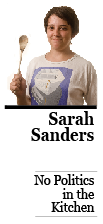Columnist Sarah Sanders offers advice for cheap, healthy lunch ideas.
One could say that many North Philadelphia residents don’t have a choice about what they eat.
Obviously there is free will when it comes to choosing between McDonald’s and a frozen meal from Fresh Grocer, but is that really a choice? The farmers market on Cecil B. Moore Avenue offers fresh options, but why  pay $5 for a loaf of bread when you can get one for less than half that price at Rite Aid?
pay $5 for a loaf of bread when you can get one for less than half that price at Rite Aid?
I might choose to buy Wonder bread, but maybe I would really like the baked-just-yesterday crust of the whole wheat Amish loaf. Perhaps I’m not even aware of the benefits of whole grains or the importance of fiber intake.
Do I still have a say in what I eat, or am I left to scarf down the products of my environment?
Giant food-franchise operations certainly have a choice to plant their outlets in neighborhoods like North Philadelphia, and do so with the anticipation of making a profit. After all, they’re creeping in on communities with a pre-established lack of revenue and progress.
Consequently, employees will work for little wages without benefits, and consumers will remain loyal, as long as the products remain within their purchasing power, i.e., the Dollar Menu stays. Forget buying bread – why even cook or prepare your own food when you can get a sandwich for a dollar plus tax?
The big advantage that you and I have over a significant chunk of the North Philly population is money. I won’t presume every student has the same level of disposable income, but through the three-and-a-half years I’ve been here, I’ve come to realize that Temple has gotten wealthier.
Kids are carrying all kinds of cash these days, so why not put your dollar where your mouth is? Like I said in the beginning of the semester, eating has become a political act.
The more money you put into convenience food, the more control you give up over what goes into your body.
There have been considerable advances in chemical engineering, as well as government subsidizing, in the past few decades that enable vendors and franchises to sell you a hamburger for a dollar.
It’s not a matter of making it more nutritious for you, but instead, a matter of mass-producing food cheaply enough so vendors can sell more goods, encourage you to buy more and ultimately make them all richer.
But what are you really paying for? The minority communities that populate North Philly are paying for significant increases in obesity, diabetes and other diet-related illnesses. But at least it was only a dollar.
This might sound like a guilt trip, but my intention is to motivate you to mix up your routine a bit. Try brown-bagging it – or rather, to be more politically correct, canvas-bagging it.
I don’t expect you to fix the system and improve the lives of thousands of low-income families, but I think it’s fair to expect something more of the relatively well-to-do college community of which you and I are a part.
Why not prepare your own lunches and avoid the mystery ingredients you find in fast food joints and convenience stores? In this edition, I give two lunch possibilities that can be consumed at room temperature and will fare well in a book bag.
Sure, I’m only giving you two options, but you probably buy the same thing at the 12th Street Food Pad Vendors every day anyway. I’ll admit that some lunch trucks are fresher than others, and you can develop a healthy relationship with your lunch truck vendor, but you can’t beat making your own food.
Sarah Sanders can be reached at sarah.sanders@temple.edu.



Be the first to comment